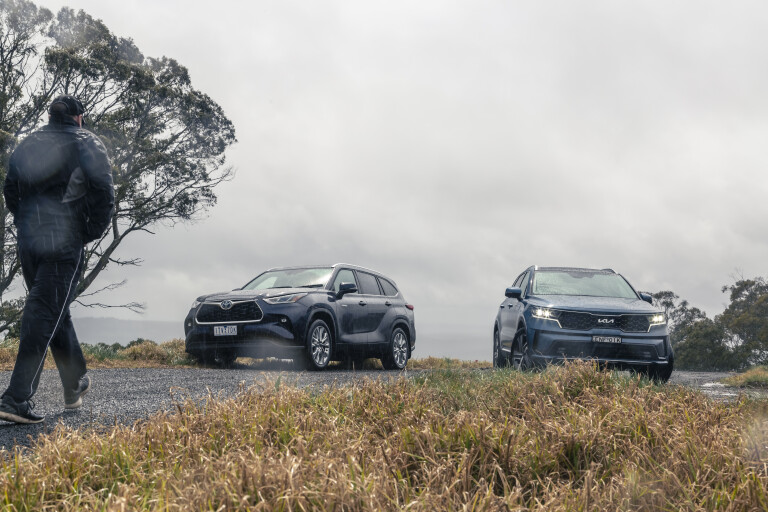
Things we like
- Sorento: Slick tech, interior practicality, country road handling
- Kluger: Seamless hybrid, urban ride comfort, affordable servicing
Not so much
- Sorento: Firm urban ride, hybrid not that frugal, still no wireless Carplay/Android
- Kluger: Front seats lack support, dated infotainment, expensive to buy
Picking between a Toyota Kluger and Kia Sorento was, historically, not very exciting. Both seven-seaters served a purpose – that being the ability to carry parents and their quintuplets in relative comfort and safety – if little more.
Launched in September 2020 and June 2021 respectively, the new Sorento and Kluger truly evolved – especially the Kia. With chiselled good looks, lashings of USB charge points and an engaging chassis, the Sorento impressed at launch, even if its 3.5-litre petrol V6 and 2.2-litre turbo-diesel didn’t move the game on like the cabin did.
That became a problem when Toyota’s new Kluger debuted on TNGA-K underpinnings packing a petrol-electric hybrid based around a 2.5-litre four-cylinder engine.
Hybrid drive promised to cut the V6 Kluger’s consumption by 40 per cent in ADR figures, and it delivered on the road.

The new Kluger was a revelation, and although the Sorento and Mazda CX-9 both possessed slightly better dynamics and more cohesive interiors, the frugal Toyota hybrid powertrain is now an Aussie staple.
The Sorento didn’t have an answer until the motoring press, dealers and customers basically begged, and Kia secured some hybrid production for Australia. It started with the rather expensive ($81,080 before on-road costs) Sorento PHEV (plug-in hybrid), shortly followed by the regular hybrid we have today available in front- ($66,750) or all-wheel drive ($69,750). Both before on-road costs.
Both of these popular three-row SUVs are in hot demand and low supply. The Kluger in top Grande hybrid eFour trim tested here ($75,700 before on-road costs) demands six to nine months of patient waiting in metro areas. There is some lightly-used dealer stock about, but the price gouging is hard to swallow.
The Sorento hybrid wait list is about 12 months long as Kia is only able to secure roughly 20 each calendar month, and there’s no dealer stock. The Sorento is still available with a 2.2-litre turbo-diesel that – as I’ll come back to – is probably better than the hybrid for country buyers.
JUMP AHEAD
- Pricing and features
- Comfort and space
- Boot space compared
- On the road
- Safety
- Fuel efficiency
- Ownership
- VERDICT
- Scoring
- Specs compared
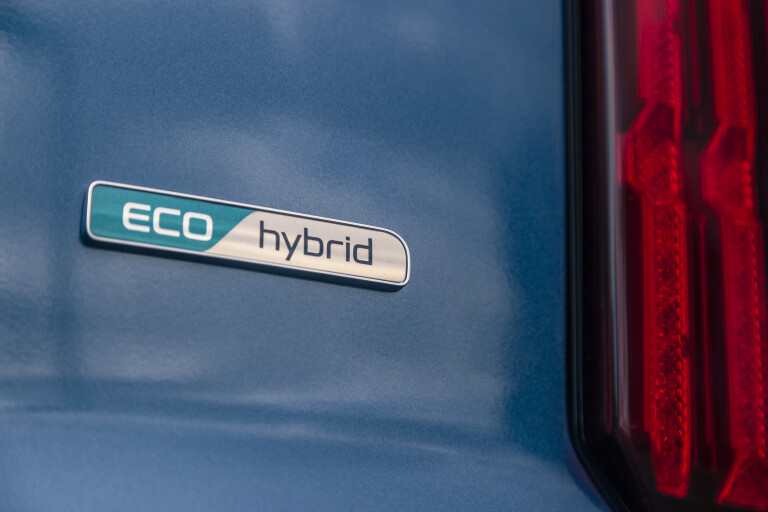
Pricing and features
Both SUVs on test are fully loaded. For the Sorento, that means the GT-Line trim and for the Kluger, Grande. If there’s a theme that runs through this twin test, it starts here. The Sorento’s Euro ‘GT-Line’ name against big-gulp Grande sums up each car’s approach.
The Sorento and Kluger have wired Apple CarPlay and Android Auto, three-zone climate control, electric front seat adjustment, leather upholstery, seat heating and cooling, name-brand sound systems, surround-view cameras and digitised driving displays.
Despite being nine months older in Australian market terms, the Sorento feels like a far newer vehicle. Its 10.25-inch central touchscreen is not only larger than Kluger’s small 8.0-inch infotainment unit, but the colours are far more vivid and the resolution higher.
The Sorento also has a 12.3-inch digital driver’s display with blind-spot cameras, whereas the Toyota has a 7.0-inch TFT screen that you can’t see properly when glared upon by Sydney’s bright sun.

Kia has also gone to town when it comes to interior presentation with ambient lighting glowing softly through fish-scale metal, art-deco-inspired design choices and nicer feeling secondary plastics. The steering wheel controls are more logically laid out in the Sorento and it has a total of eight USB charging points against Kluger’s five.
Some may find the Kluger’s back-seat Blu-Ray entertainment system (a $1500 option) dated in a world of iPads, but it’s actually a great way to re-explore the family’s entertainment collection. The included infrared headphones mean parents in the front will be able to enjoy blissful silence.
If the front seat passengers want to listen to music, the Kluger’s 11-speaker JBL stereo is powerful but the Sorento’s warmer, more natural-sounding Bose system is easier on the ears.
While the Kluger is absolutely fit for purpose (and some may like the choice of two interior colour schemes, which certainly differs from Kia’s black-or-black), the Sorento’s technology package and cabin design are more cohesive.

Sorento GT-Line and Kluger Grande hybrid features
| Sorento GT-Line hybrid | Kluger Grande hybrid |
|---|---|
| $69,750 ($70,445 as tested*) + on-road costs | $75,700 ($77,875 as tested**) + on-road costs |
| 10.25-inch touchscreen | 8.0-inch touchscreen |
| 12.3-inch digital driver’s display | 7.0-inch TFT readout |
| 12-speaker Bose sound system | 11-speaker JBL sound system |
| 14-way power heated and cooled seats | 14-way power heated and cooled seats |
| Quilted Nappa leather upholstery | Leather upholstery (tan or black) |
| Tri-zone climate control | Tri-zone climate control |
| Keyless entry and go | Keyless entry and go |
| Power tailgate | Power tailgate |
| Projector LED headlights | Projector LED headlights |
*Premium paint ($695)
**Premium paint ($675), rear-seat entertainment ($1500)
Comfort and space
The Kluger gets off to a fantastic start as you sink into its soft, Werther’s Original-inspired leather-upholstered seats with three-stage heating and cooling (black leather is available too). The driving position feels suitable for a taller driver, too, which worked for me at 188cm.
Initial comfort in the Kluger gives way to long-distance fatigue that the Sorento’s firm quilted Nappa leather-appointed seats don’t introduce. The Kia’s pews are less plush but more supportive on long hauls. It, too, has electric seat adjustment with memory, heating and cooling, but there's more adjustment and heaps of under-thigh support to keep leg fatigue at bay.
The second row is where the Kluger draws ground back (except for the lack of seat heating, which is a weird miss). A longer vehicle simply has a little more space, with better headroom and legroom than a Sorento. Both SUVs have a separate rear climate zone, built-in sunshades and sliding benches with adjustable backrests.
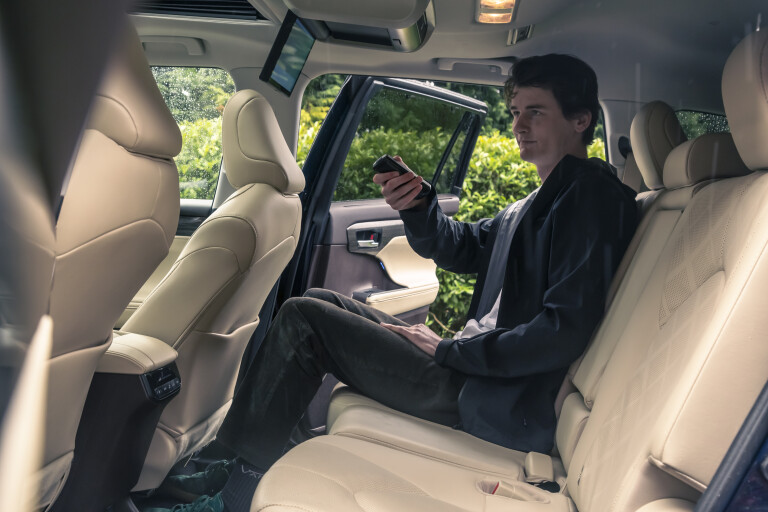
It would be nice if the Sorento offered another upholstery choice rather than simple-but-safe black. The Kluger’s brown and tan isn’t, perhaps, so on the money but the Sorento’s Hyundai Santa Fe Highlander relation has a lovely cream upholstery option worth considering outside this twin test.
On the whole, this pair is sturdily constructed inside. Having a full-length opening sunroof is great in the Sorento, though I noted some rattles and creaks over broken tarmac during our test week that were not evident in the Kluger.
The second rows of both Kluger and Sorento have three ISOFIX points and top tether anchors for securing child seats. While the Kluger one-ups the Sorento by having curtain airbags that protect occupants all the way at the back, there are no top tether or ISOFIX points in the third row of the Toyota – unlike the Sorento, which has both.
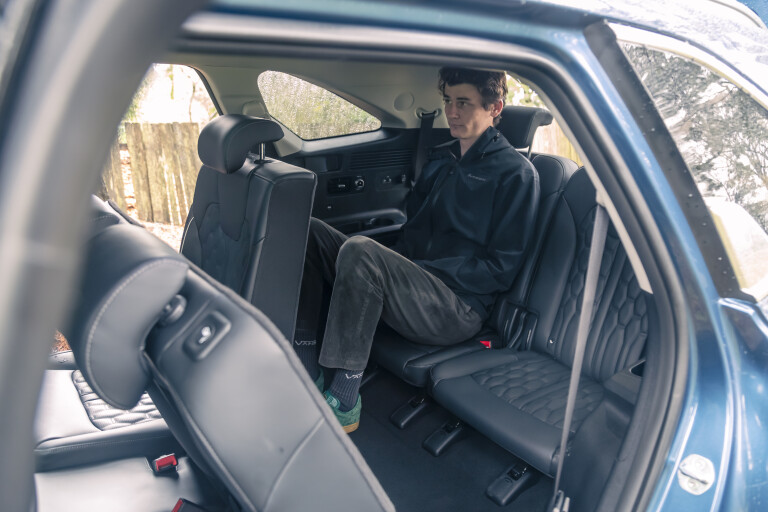
Space in the Sorento’s third row is more impressive than the Kluger. Despite the sunroof, there is more headroom than the physically bigger Kluger.
That physical size does help the Kluger in boot space. It offers 241L against Sorento’s 179L with all three rows in place. The seats fold easily in both cars, with five-seat mode netting 552L in Kluger and 608L in Sorento. Kia’s ease of use is excellent, with an electrically actuated folding second row flipping down with almost no effort, whereas the Kluger’s manually folding seats require a certain amount of huffing and puffing.
Despite hybrid powertrains, both vehicles are equipped with full-sized spare tyres. Power tailgates are standard, naturally.

Sorento GT-Line and Kluger Grande hybrid boot comparison (VDA)
| Seats in place | Sorento GT-Line hybrid | Kluger Grande hybrid |
|---|---|---|
| Seven seats | 179L | 241L |
| Five seats | 608L | 552L |
| Two seats | 1966L | 1150L |
On the road
We’ve driven both of these family SUVs at Wheels before, but never directly back-to-back. Mostly, the Kluger and Sorento’s driving traits carry over from pure ICE vehicles, so it’s really about the polish and integration of each car’s hybrid systems.
Kia uses a direct-injected 1.6-litre turbo-petrol engine with a single 44kW/264Nm electric motor. You can get a Sorento hybrid in front- or all-wheel drive and the peak 169kW/350Nm outputs are the same. This is due to Kia’s system sandwiching the electric motor between the engine’s output shaft and gearbox.
This also means the Kia keeps a traditional six-speed automatic rather than the Kluger’s continuously variable transmission. While this can make for some awkward low-speed manoeuvres as the Sorento transitions between electric and petrol power, it also keeps the engine’s din at bay better than a Kluger’s.

Unfortunately, the Kia’s electrics simply don’t have as much grunt. There’s no optimistic EV mode – only Eco, Smart, Sport and a host of off-road settings – and oftentimes when taking off from the lights the Kia’s petrol engine will kick in where the Kluger’s wouldn’t.
In terms of urban operation and efficiency then, the Kluger takes the cake.
Toyota’s hybrid is rather different to Kia’s, the Kluger tested here equipped with the proven ‘eFour’ powertrain. This comprises three electric motors – one for battery regen, another (134kW/270Nm) to help the petrol engine at the front axle and a free radical for the rear wheels.
All this is both good and bad. In theory, (and in practice) it makes the Kluger more efficient. It also gives independence to the rear axle, though the rear motor’s outputs (40kW/121Nm) don’t match the front axle for a true 50:50 AWD torque split. Total system power is quoted at 184kW; Toyota does not claim a combined torque figure.
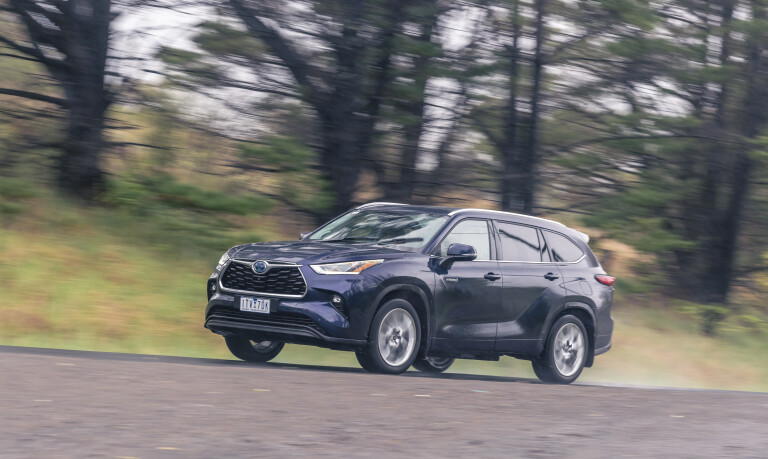
So the Kluger’s powertrain is better, hands down then. Right? Well, not quite, because even though Toyota’s CVT is smooth and seamless, the Atkinson-cycle 2.5-litre atmo four-banger is not as refined as the Sorento’s 1.6.
That means when kicking the Kluger to 100km/h in a claimed 8.4 seconds, it can get quite noisy. This is expected, but a similar level of noise comes through when making brisk getaways from the lights in Sport mode.
Despite being down on power, the lighter Sorento (1948kg vs 2090kg) ought to be a little quicker than the Kluger, though Kia doesn’t claim a 0-100km/h time, and they feel about the same on the road.
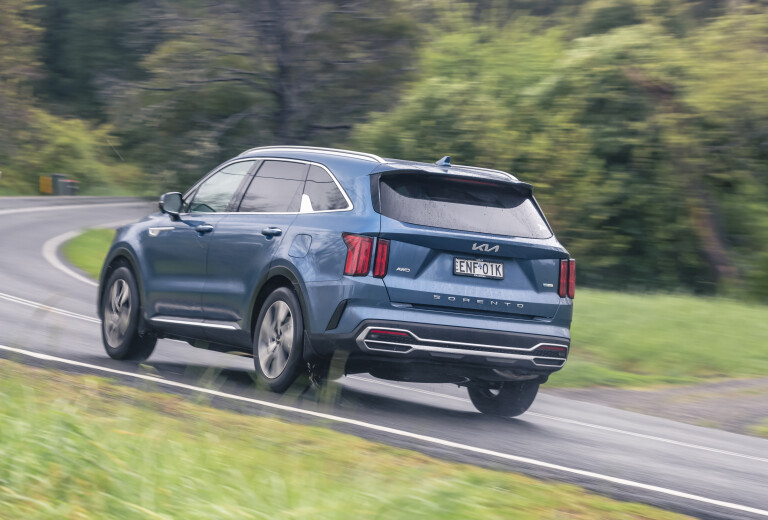
I mentioned Europe vs USA earlier, and I think Westerman put it best when he leaned into the Kluger window and said to me: “This is a simple call, it’s Europe vs the USA”.
What you value in a vehicle will probably determine your preference between these two. For those after ultimate plush comfort, the softly-sprung and almost underdamped Kluger will suit your tastes.
Crawling slowly through Sydney’s pothole- and concrete-littered inner west suburbs, the Kluger’s soft springs and long travel soaked up road imperfections best, the Sorento being occasionally abrupt, even on its smaller 19-inch alloy wheels (the Kluger wears 20s).
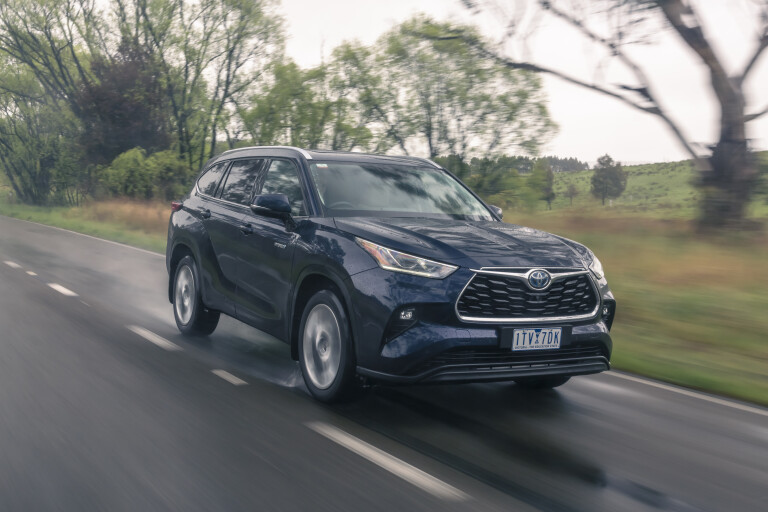
Both are easy to see out of and park, but the Sorento’s more compact 4.86-metre length means it fits into more spots than the 4.96-metre-long Kluger. The Sorento’s blind-spot cameras that come on with the indicators seem gimmicky at first, but add an extra layer of confidence when changing lanes or turning left in the vicinity of motorcyclists.
The Kluger’s ride comfort was welcome on a 90-minute jaunt out of Sydney on the M5 and Hume Highway. The Kluger is a truly plush vehicle with enough body movement to isolate all seven passengers. I do wonder how the car’s dampers will age over time, though, as it sometimes takes two oscillations to settle after a high-speed compression.
Away from the straight-and-dull Hume is where the Sorento’s Australian-tuned chassis comes to the fore. This pair isn’t about on-limit dynamics, of course, but the Sorento’s secure and natural handling inspired more confidence on unsighted wet roads. The Kluger isn't a sloppy mess in the country, but for us at Wheels, the Sorento wins out for overall prowess.
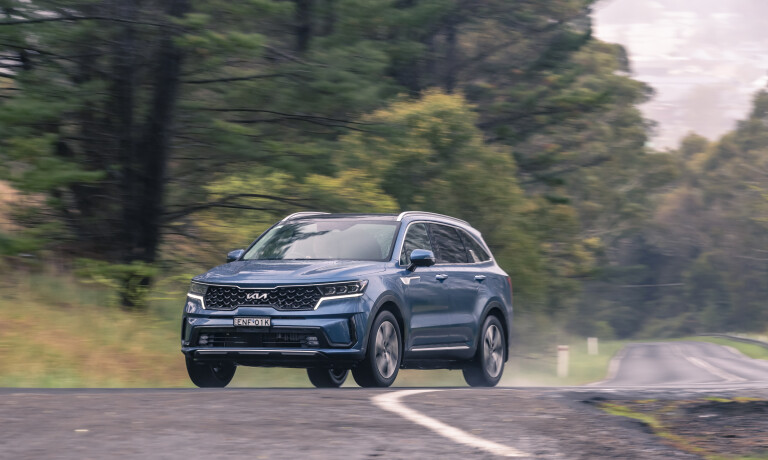
Safety
In the safety aids department, the Sorento’s high-res 360-degree monitor and blind-spot cameras in the digital driver’s display give it a massive advantage over the Toyota – seriously, the Kluger’s pixelated surround-view monitor is almost unusable.
Both cars have front auto emergency braking with pedestrian and cyclist detection, blind-spot monitoring, rear cross-traffic alert, lane-departure warning and adaptive cruise control.
The Kluger and Sorento both have semi-autonomous modes that combine adaptive cruise and lane-trace assist. Neither works particularly well, with lots of bouncing from one side of the lane to another. The Toyota’s system also slows down particularly early when approaching vehicles from behind on the highway.
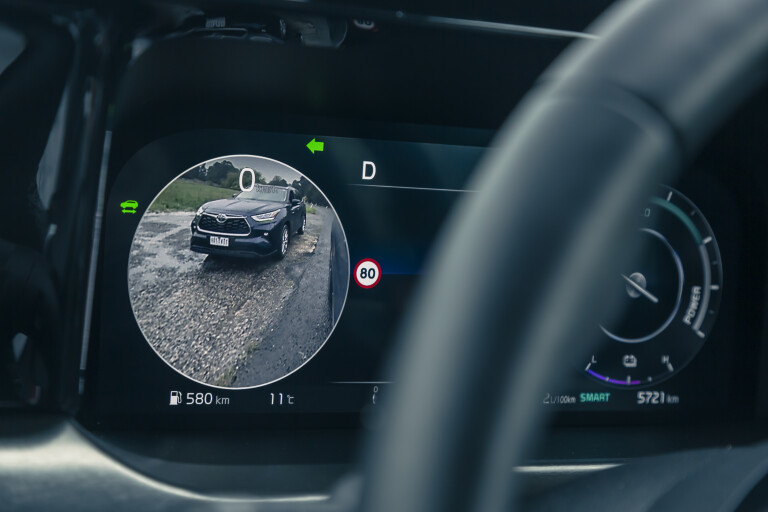
Fuel efficiency
Each of these vehicles promises to nearly halve fuel usage next to their petrol V6 counterparts. The Sorento AWD is rated at 5.8L/100km and the Kluger 5.6L/100km on the ADR combined cycle.
Our real-world urban testing showed that the Kluger was demonstrably more efficient around town, recording a flat 8.0L/100km. The Sorento’s electric motors simply aren’t as strong, which means more time using the petrol engine and a 9.2L/100km figure in town.
Both cars improved while heading down to the Southern Highlands from Sydney for a more in-depth test, though the Sorento’s more frugal 1.6 turbo-petrol engine showed greater potential, dropping to 7.1L/100km against the Kluger’s 6.9L/100km.
The crutch is, the Sorento’s 2.2-litre turbo-diesel is just as efficient as the hybrid for country touring with an ADR extra-urban rating of 5.3L/100km. Its 2000kg braked towing capacity is also more useful than the hybrid’s 1650kg, plus you save $4680 on the purchase price. If you really want to lower your fuel consumption – especially around town – the Kluger wins here.
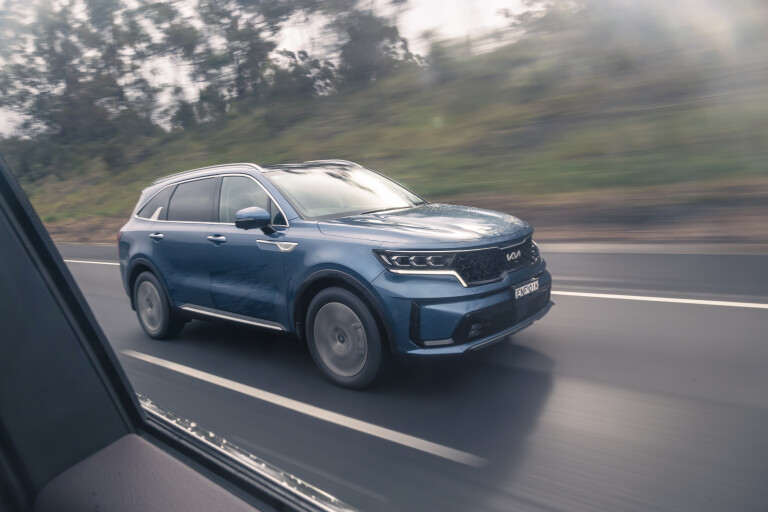
Ownership
The same is true over a longer period. The Sorento may be $5960 cheaper to buy than the Kluger but in the first five years, you’ll spend $1816 more on scheduled maintenance – not a small sum.
For five years or 75,000km of maintenance, the Sorento costs $2841 and the Kluger just $1025. The Kluger’s capped-price servicing runs out after five years though, whereas the Sorento’s runs for seven.
Sorento also hits back with a seven-year, unlimited-kilometre warranty to Toyota’s five. The Toyota’s more proven hybrid powertrain and atmo engine may, for you, go some way to ease any worries about its shorter warranty.
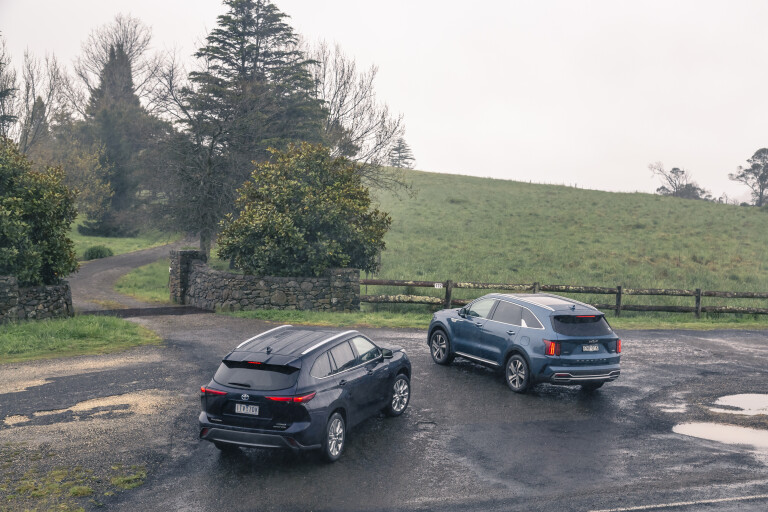
VERDICT
Throughout the test, Ash and I were bickering over the Sorento's keys. Its attractive cabin with surprising delights like the ambient glow through the ‘fish scale’ trim is just scratching the surface of its brilliance. Except, with the Kia's fuel consumption figures, I’d seriously consider saving some cash and getting the diesel.
A Kluger, on the other hand, undeniably succeeds at cutting local emissions and lowering fuel consumption in urban settings. If that’s the sole reason you’re tossing up between Kluger and Sorento hybrids, then the Kluger is where you’ll end up – with the bonus of a very plush ride.
The Sorento’s more supportive seats, better sound system, and more cohesive ride and handling package mean this is the car I’d buy with my money though, and the winner of the test.
Overall, the Sorento does more with the space it has and is the more complete package.
SCORING
Kia Sorento GT-Line HEV AWD: 8.5/10
Things we like
- Slick technology
- Interior practicality
- Country road handling
Not so much
- Firm urban ride
- Hybrid isn’t that frugal
- Still no wireless mirroring
Toyota Kluger Grande hybrid eFour: 8.0/10
Things we like
- Seamless hybrid
- Urban ride comfort
- Affordable servicing
Not so much
- Front seats lack support
- Dated infotainment
- Expensive to buy
| Toyota Kluger Grande hybrid AWD | Kia Sorento GT-Line hybrid AWD | |
|---|---|---|
| Safety, value and features | 8 | 8.5 |
| Comfort and space | 8.5 | 8.5 |
| Engine and gearbox | 8.5 | 8 |
| Ride and handling | 7.5 | 8 |
| Technology | 7.5 | 8 |
| Overall | 8.0/10 | 8.5/10 |
2022 Kia Sorento and Toyota Kluger hybrid specifications
| Toyota Kluger Grande hybrid eFour | Kia Sorento GT-Line HEV | |
|---|---|---|
| $75,700 ($77,875 as tested**) + on-road costs | $69,750 ($70,445 as tested*) + on-road costs | |
| DRIVETRAIN | ||
| Engine | 4cyl, dohc, 16v, Atkinson cycle | 4cyl, dohc, turbo, direct-injected 16v |
| Layout | front engine (east-west) + tri motors (F + R), AWD | front engine (east-west) + single motor, AWD |
| Capacity | 2487cc | 1598cc |
| Power | 184kW | 169kW |
| Torque | not stated | 350Nm |
| Gearbox | continuously variable | 6-speed automatic |
| CHASSIS | ||
| Body | steel, 5 doors, 7 seats | steel, 5 doors, 7 seats |
| L/W/H/W–B | 4966/1930/1755/2850mm | 4810/1900/1700/2815mm |
| Track (F/R) | 1660/1660mm | 1660/1660mm |
| Weight | 2090kg | 1948kg |
| Boot | 241/552/1150L | 179/608/1996L |
| Fuel/tank | 91 RON / 65 litres | 91 RON / 67 litres |
| Economy | 6.9L/100km (tested) | 7.1L/100km (tested) |
| Suspension | Front: struts, coil springs, anti-roll bar. Rear: multi-link, coil springs, anti-roll bar | Front: struts, coil springs, anti-roll bar. Rear: multi-link, coil springs, anti-roll bar |
| Steering | electric rack-and-pinion | electric rack-and-pinion |
| Front brakes | ventilated discs (340mm) | ventilated discs (325mm) |
| Rear brakes | ventilated discs (338mm) | Ventilated discs (325mm) |
| Tyres | Toyo Open Country AO20 | Goodyear Eagle F1 SUV |
| Tyre size | 235/55R20 | 235/55R19 |
| SAFETY | ||
| ANCAP rating | five stars | five stars |
| PERFORMANCE | ||
| 0-100km/h | 8.4sec (claimed) | 8.5sec (estimated) |
| **Premium paint ($675), rear seat entertainment pack ($1500) | *Premium paint ($695) | |
Things we like
- Sorento: Slick tech, interior practicality, country road handling
- Kluger: Seamless hybrid, urban ride comfort, affordable servicing
Not so much
- Sorento: Firm urban ride, hybrid not that frugal, still no wireless Carplay/Android
- Kluger: Front seats lack support, dated infotainment, expensive to buy

COMMENTS